Have you ever tried an eyedropper filled pen? I hadn't, until this week! We've been carrying Opus 88 fountain pens from Taiwan for a while, but recently received some unique new colors that really caught my eye. Opus 88's pens are all eyedroppers, and I thought it would be a cool topic to explore. My "For Your Penjoyment" co-host, Leila, bought two of them, so I asked her to tell me about her love for Opus 88 and her experience using eyedropper pens. Not only did she gladly answer my questions, she loaned me one of her brand-new pens so I could experience it for myself!
Eyeing the Eyedroppers
What is an "eyedropper pen," anyway? To put it simply, an eyedropper filled fountain pen, or "eyedropper" for short, is a pen whose entire barrel serves as its ink reservoir. There is no cartridge, cartridge-converter, or sac. You don't use a piston or vacuum -filling mechanism to get the ink into the pen. Filling the pen is very straightforward. You unscrew the pen's front section and fill the body of the pen directly, using an eyedropper or a blunt syringe to transfer ink from a bottle into your pen.
The advantage of this type of pen is that it can hold a lot more ink; however, it's very important that the eyedropper pen be made correctly, have no holes or cracks in the body, and have a watertight seal between the barrel and grip section. Many eyedroppers are pens that the user has modified from a plastic cartridge/converter style pen (such as a Kaweco Sport or Platinum Preppy) by applying silicone grease to the threads, and, occasionally, adding an o-ring. "Eyedroppering" your pen can be really cool, but it's also risky! If the pen isn't sealed correctly, you'll have a huge mess on your hands (and on anything else that comes in contact with your leaky pen!).
If you want to experience a much less scary eyedropper, the Opus 88 fountain pens were designed as eyedroppers right from the start, with lots of clever design features that prevent leaks and keep your pen running smoothly. They are simple and fun to use, and are great writers as well, with interchangeable Jowo nibs made in Germany. I'll walk you through how to fill them and use their special features later in this article.
We currently carry two Opus 88 models: the Demo and the Jazz, both of which use the #12 nib and are available in a wide range of nib sizes, including stub and flex. We only have one Jazz color in stock right now (a clear demonstrator), so I'll focus on the slightly smaller Demo, a demonstrator pen that comes in an assortment of shades, from the pure and simple Demo Clear to the whimsical confetti-like Demo Color, to a bold translucent Demo Red and the 2024 colorblocked Demo Pink and Demo Green. We recently got the ocean-inspired limited edition Demo Dolphin and Demo Turtle variations, and Demo Turtle sold out almost immediately. (We still have a few Demo Dolphins left, but probably not for long!) Even more striking is the 2024 Demo Sapphire, a swirling mix of deep shimmering blues. It simultaneously reminds me of the earth from space, a galaxy, and the ocean.

Leila's Pens
Leila bought a Demo Sapphire and a Demo Green, so on Tuesday when we were working on planning the next episode of "For Your Penjoyment" together, she let me try her Demo Sapphire, which she'd inked with Diamine Enchanted Ocean, a gorgeous dark teal-leaning blue with lots of shading and silver shimmer. Leila is a superb ink/pen matcher, and this combination was no exception.

The pen felt a little large and chunky in my hand at first, but it's fairly lightweight and very well-balanced, so I soon got pretty comfortable. The grip section is 11.7 mm, slightly larger than my Estie, which has a 11.1 mm grip. It's also a few grams heavier than my Estie, and is shaped more like a TWSBI Eco, with squared-off, rather than tapered, ends. The Opus 88 Demo's cap can't be posted on the back of the pen, and I wouldn't have wanted to, anyway, because it would have made the pen much too long and thrown off the balance. Although I wasn't immediately sure how I felt about the shape, my first impression was that using the Opus 88 was fun. There was just something about the pen that felt playful and made me fond of it. Leila's broad nib was very smooth, and squeaked a little as I wrote, a sensation that made me laugh. Leila told me the squeak goes away after you break it in, then added, "I've been writing with this all weekend, and it's been a dream."
She went on to tell me that she got her first two Opus 88 pens about a year ago, so, with her two new pens, she now owns four. The Opus 88 was her first eyedropper, and learning to fill it was no more scary than figuring out how to use a piston-filler for the first time. She confided, "I favor it a little more [than a piston-filler]... it's much easier to clean. Like, by far. And, it's not like disassembling a TWSBI." She noted that, for her, taking apart a TWSBI "can be fun," but "isn't practical in the same way" that rinsing out an Opus 88 is.
The ink capacity in the Opus 88 Demo is huge--3.4 ml--which is more than even the largest TWSBI (the Vac 700R has a maximum ink capacity of around 2.3ml), and more than you get in many commercially available ink samples. This seems to me like a lot of ink to put in your pen at one time, but Leila loves it. "Because I'm so matchy-matchy [with my pens and inks], I tend to stick with one ink for a pen, so having that capacity makes life easier. There's nothing more frustrating than finding your creative flow and then your pen suddenly runs out of ink. I worry less with my Opus 88." I don't write as much with my pens as Leila does, but that does sound like a big advantage if you're a prolific writer and stick to the same ink for a long time!

Leila's four ink picks for her Opus 88s are Enchanted Ocean and Tropical Glow from Diamine, and Félicette Glistening and Mystic Mountain from Colorverse. When I expressed surprise that they are all shimmer inks, she said, yes, all her Opus 88 pens have broad nibs, and two have clear barrels. She likes being able to see the pretty ink and the shimmer distribution through the barrels. Makes sense!
I also talked with one of my favorite customers, Mikele, who recently bought the Demo Sapphire in extra fine and loves it. She tested a broad, but personally preferred the feeling of the fine and extra fine nibs. Mikele told me, "The extra fine feels surprisingly as crisp as the Kakuno!" She brought her pen to the store on Friday so I could try the nib myself, and I was amazed by how smooth but precise it is. What a beautiful writer! Mikele, like Leila, said, "the eyedropper experience is great." Although using an eyedropper pen seems very different at first, getting to know it is a quick and easy experience.

The Eyedropper Experience
Leila gave me her unused Demo Green pen and matching Tropical Glow ink to take home so I could fill the pen and see for myself how simple it is. She didn't instruct me on how to do it, so I watched one video on YouTube, then jumped right in. I am not a tinkerer, and I never take apart my TWSBI Diamond Mini, but this was fun! Instead of being scary, it felt like I was playing with a toy.
The process is really simple:
1) Disassemble the pen by removing the cap and then unscrewing the grip section from the barrel. It can feel a little hard to turn at first, compared to your cartridge-converter pens, but, remember, the pen needs a tight seal so it won't leak. It will probably squeak, and feel a little boingy from the little black rubber o-ring gasket.

2) Open the shut-off valve by loosening the blind cap at the bottom of the pen. (Opus 88 calls this part of the pen the "bottom tail"!) Again, it will be a little hard to turn, but don't be afraid--you won't break it! Keep unscrewing, and use a little elbow grease to pull it out so there's a gap between the threaded part and the barrel of the pen. You'll see the black plunger rod inside that connects to an ebonite piston and rubber gasket that seals the feed off from the barrel when fully depressed.

3) Fill the barrel with ink by using the eyedropper provided in your box to suck up ink from a bottle and release it directly into the open barrel of your pen. You can also use a blunt syringe for this step if you want a little more control. (Note that, in addition to giving you a nice glass eyedropper, Opus 88 also includes a spare o-ring!) I really liked Opus 88's glass eyedropper, because it's easy to disassemble the rubber bulb from the tube and rinse the whole thing clean.

I also thought it was cool that the Demo model's flat bottom serves a practical purpose during this step! The pen is capable of standing up on its own and is quite stable, as long as you don't accidentally knock it over. This is very handy, since you don't even need to hold it if you want to use both hands to control your syringe. Remember, the barrel holds a lot of ink, so you'll need multiple eyedroppers full if you want to fill it up all the way.

4) Set aside your inky eyedropper or syringe, and, holding the pen with the open end up, screw the grip section back onto the barrel. Make sure it's fully closed, nice and tight.

5) Now, with the nib facing downward, screw the shut-off valve closed. This will prime the feed for you. My ink didn't reach the nib right away, so I stood the pen on its "head" (cap down) for a few minutes to allow the ink to flow downward. In less than five minutes, the pen was ready to write!

You can also prime the feed when the pen has been sitting for a while, to get the ink flowing. All you have to do is unscrew the blind cap, pull the piston outward, and push it slowly back in. Don't be afraid to pull it out far! This is an especially great trick to have up your sleeve if you're using shimmer ink, which can settle and clog pens. Just use the plunger to expel a drop of ink onto a piece of paper or cloth, and the pen will start writing perfectly again.

Delightful Demo Design
I really enjoyed the process of filling the Demo, and how hands-on and straightforward it was. It made me feel in touch with the pen, sort of like the nice feeling of planting a plant with your hands in the dirt. Instead of seeming intimidating, the experience felt friendly and easy-going, and I felt like I was playing rather than working to fill it. The simple parts, blocky shape, and joyful, quirky color combinations in many of the pens add to the charming toy-like feel. All the pens have their own personalities. I love the Demo Pink because I just think the combination of colors is so pretty! It reminds me of spring. I'm not usually a pink person or a demonstrator pen person, but the luminous flamingo shade, purple grip section and blind end cap, teal blue top finial, and green Opus 88 logo on the cap are delightful together.
 I also love how the Demo Pink and Demo Green pens play off each other, sharing some colors but keeping others to themselves. The pink pen's teal blue top finial matches the blind end cap of the green pen, and the green pen has a pink logo, while the pink pen's logo is the spring green of its counterpart's grip and top finial. They make a great team!
I also love how the Demo Pink and Demo Green pens play off each other, sharing some colors but keeping others to themselves. The pink pen's teal blue top finial matches the blind end cap of the green pen, and the green pen has a pink logo, while the pink pen's logo is the spring green of its counterpart's grip and top finial. They make a great team!

These pens all combine acrylic and ebonite pieces, which work together in a lovely and unique way, and the translucence of the materials has a different look than most demonstrator pens. I enjoyed being able to see inside the pens, especially because there aren't extra parts like converters or cartridges blocking your view of the beautiful ink sloshing around in the barrel.
There's one more thing you need to know about the Opus 88's mechanism. Its shut-off valve needs to be open in order for the ink to keep flowing, so unscrew the end cap a little bit and create a small gap if you're going to be using the pen for more than a few quick notes. Unscrewing it so you can see all the threads but not the black rod is a good amount. When you're done writing, screw the end cap closed again, and this will seal off the feed and stop air flow. You can carry the pen without any worries about it "burping" ink. This mechanism also will keep your pen from leaking if you fly with it and it is exposed to changes in air pressure. With the shut-off valve closed, the ink will run dry after a short time, and no more ink will flow between the barrel and the nib. I used Leila's green pen to take stream-of-consciousness notes on my immediate Opus 88 experience, then closed it back up to store when I was done. On page two, I wrote, "Sort of irresistible."
If you decide to get an Opus 88, you can go for a more serious look by choosing the stunning Sapphire colorway, which is the least translucent, or, at the other extreme, the Clear Demo, beautiful in its pure simplicity.
 For a really fun and happy pen, choose the confetti-esque Demo Color, which feels like your own little party.
For a really fun and happy pen, choose the confetti-esque Demo Color, which feels like your own little party.
 And, for ocean animal lovers, the beautiful limited edition Demo Dolphin offers a surprisingly sophisticated seascape populated with a pod of leaping dolphins shining silver in the sunlight. We only have a few left, so it may sell out before this article is published, but I loved being able to experience it. (It even won our recent ocean-themed Battle of the Pens on Instagram!) I wonder what Opus 88's next creative release will be? Now that I have my eye on this brand, I'm excited to find out!
And, for ocean animal lovers, the beautiful limited edition Demo Dolphin offers a surprisingly sophisticated seascape populated with a pod of leaping dolphins shining silver in the sunlight. We only have a few left, so it may sell out before this article is published, but I loved being able to experience it. (It even won our recent ocean-themed Battle of the Pens on Instagram!) I wonder what Opus 88's next creative release will be? Now that I have my eye on this brand, I'm excited to find out!
-Laura P.
I love comments on my blog! Please leave comments if you like the articles, and, if you have any questions about this article, or any of the other blog articles, you can e-mail support@penboutique.com. Thank you!


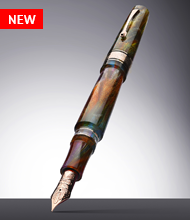


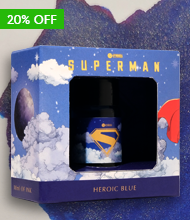


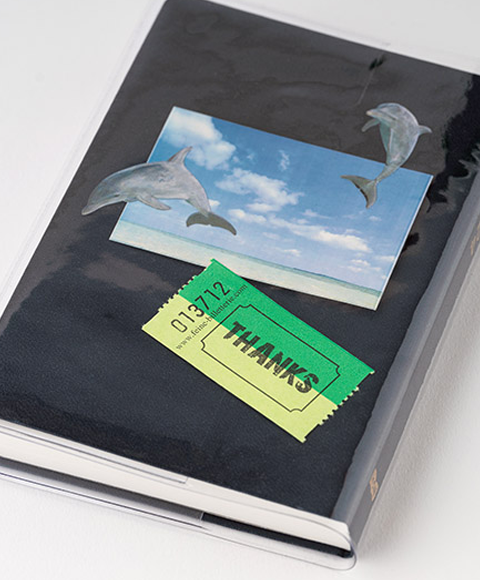

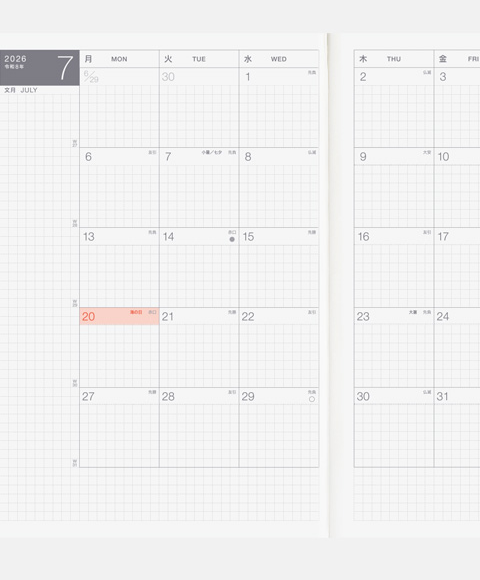




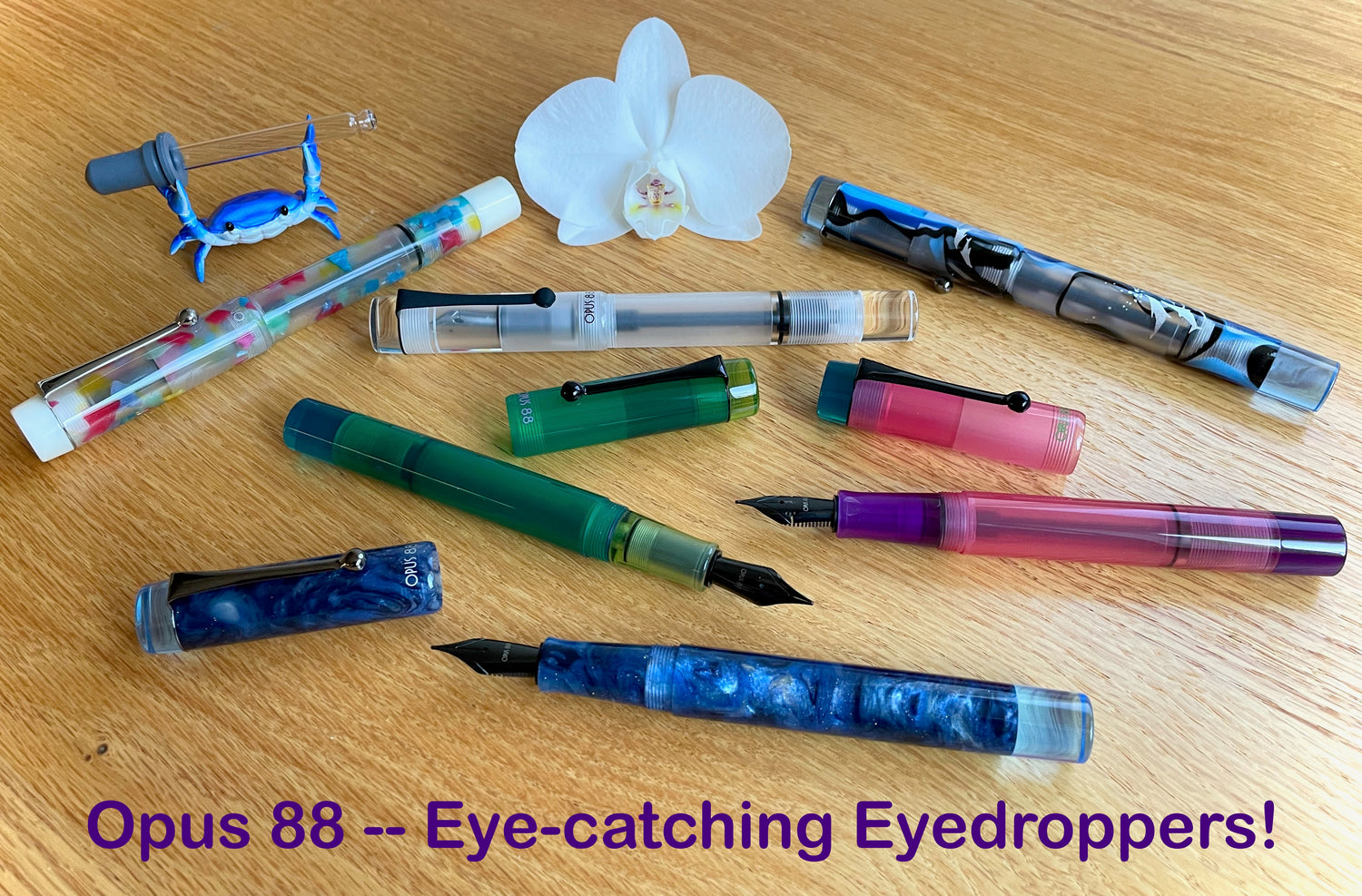





6 comments
Eric Arnold
Thank you for this topic Laura, I knew there were eyedropper pens, but knew absolutely nothing about them. Timely article just before the Baltimore Pen Show, perhaps I’ll be able to see some vintage eyedroppers there! I like the way the Opus 88 can be stood on end to fill, but I can guarantee you I’d knock it over and have ink everywhere in a heartbeat! Were I to go this route, I think some sort of pen holder (test tube rack?) would be in my future as well. Love the crab holding the eyedropper! As always, an informative and well written article, thanks so much!
Thank you for this topic Laura, I knew there were eyedropper pens, but knew absolutely nothing about them. Timely article just before the Baltimore Pen Show, perhaps I’ll be able to see some vintage eyedroppers there! I like the way the Opus 88 can be stood on end to fill, but I can guarantee you I’d knock it over and have ink everywhere in a heartbeat! Were I to go this route, I think some sort of pen holder (test tube rack?) would be in my future as well. Love the crab holding the eyedropper! As always, an informative and well written article, thanks so much!
Judy
Good review! Thanks. I really appreciate your pointing out the application of the flat barrel end for letting the pen sit up, and the clear instructions for filling and using the internal plunger mechanism. Good going! I own one Opus 88, the Baby Beluga. It is unbelievably cute. I believe the company is willing to design pens with brand-exclusive designs. Your remarks about cleaning the TWSBI are perfect! It is so hard to get all the residue out of those things, and then reassembling it is a huge pain. Maintaining the Opus 88, on the other hand, is a relative breeze. Or wave, as so many designs are ocean-related.
Good review! Thanks. I really appreciate your pointing out the application of the flat barrel end for letting the pen sit up, and the clear instructions for filling and using the internal plunger mechanism. Good going! I own one Opus 88, the Baby Beluga. It is unbelievably cute. I believe the company is willing to design pens with brand-exclusive designs. Your remarks about cleaning the TWSBI are perfect! It is so hard to get all the residue out of those things, and then reassembling it is a huge pain. Maintaining the Opus 88, on the other hand, is a relative breeze. Or wave, as so many designs are ocean-related.
Kit
I love my Opus 88s. I have the clear and the red large demonstrators, and a smaller Picnic, as well as one of their little pocket pens, Cup of Comfort. I have to say the nibs are very different on all four nibs. They’re all medium nibs, but they each write differently. That being said, I still want another Opus 88. There aren’t very many pen manufacturers that do a particularly good job of sealing air flow away from the nib when it’s capped. This is crucial to me as I keep a large number of pens inked at one time. I’m fighting ink evaporation and prioritize pens that have a good seal when the cap is on. Even without utilizing the internal sealing valve on the Opus, it still does a great job of sealing when the nib is capped. An eyedropper pen with a great seal protects these ink from evaporation. To me, this is gold.
I love my Opus 88s. I have the clear and the red large demonstrators, and a smaller Picnic, as well as one of their little pocket pens, Cup of Comfort. I have to say the nibs are very different on all four nibs. They’re all medium nibs, but they each write differently. That being said, I still want another Opus 88. There aren’t very many pen manufacturers that do a particularly good job of sealing air flow away from the nib when it’s capped. This is crucial to me as I keep a large number of pens inked at one time. I’m fighting ink evaporation and prioritize pens that have a good seal when the cap is on. Even without utilizing the internal sealing valve on the Opus, it still does a great job of sealing when the nib is capped. An eyedropper pen with a great seal protects these ink from evaporation. To me, this is gold.
Barry
I may havd missed it. Does it burp ink?
I may havd missed it. Does it burp ink?
Daniel F
Great article, I love my Demo Clear Opus 88. It’s a real workhorse of a pen. I use mine for NaNoWriMo, which is about writing quantity vs. writing quality (getting those creative juices flowing). The absolute ocean of ink this pen contains is very helpful for that. I will say, it takes longer to use all the ink, but once you do there’s a great feeling of satisfaction that you wrote all of those words down, and the re-filling is just as satisfying. It’s a motivator.
I would advise that after some prolonged use, keeping some silicon grease handy. The Opus 88 will benefit from a re-application of grease every once in a while.
Great article, I love my Demo Clear Opus 88. It’s a real workhorse of a pen. I use mine for NaNoWriMo, which is about writing quantity vs. writing quality (getting those creative juices flowing). The absolute ocean of ink this pen contains is very helpful for that. I will say, it takes longer to use all the ink, but once you do there’s a great feeling of satisfaction that you wrote all of those words down, and the re-filling is just as satisfying. It’s a motivator.
I would advise that after some prolonged use, keeping some silicon grease handy. The Opus 88 will benefit from a re-application of grease every once in a while.
Charlene
What a great article! I’ve purposely stayed away from eyedroppers because, well, I tend to make a mess just changing ink cartridges. But you’ve made filling the pen sound like fun. Guess it’s time to check out the Opus 88. Thanks for that little “shove down the rabbit hole”, lol.
What a great article! I’ve purposely stayed away from eyedroppers because, well, I tend to make a mess just changing ink cartridges. But you’ve made filling the pen sound like fun. Guess it’s time to check out the Opus 88. Thanks for that little “shove down the rabbit hole”, lol.